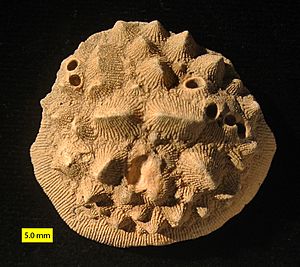Hexacorallia facts for kids
Quick facts for kids Hexacorallia |
|
|---|---|
 |
|
| A stony coral, Acropora latistella | |
| Scientific classification |
|
| Kingdom: | Animalia |
| Phylum: | Cnidaria |
| Class: | Anthozoa |
| Subclass: | Hexacorallia |
| Orders | |
Hexacorallia is a large group of sea animals. They are part of the Cnidaria family, which also includes jellyfish. Hexacorallia are sometimes called "six-corals" because their bodies often have parts arranged in groups of six. This group includes all the stony corals, sea anemones, and tube anemones. Many of these animals live in colonies and help build amazing coral reefs in the ocean.
Contents
What are Hexacorallia?
Hexacorallia are a major group of animals that live in the ocean. They are a type of Anthozoa, which means "flower animals." All Hexacorallia are polyps. A polyp is a small, soft-bodied animal with a mouth surrounded by tentacles.
There are about 4,300 different kinds of Hexacorallia. Most of them have a body plan with six or fewer parts arranged around a central axis. Their tentacles usually grow in single rows.
How Hexacorallia are Different
Hexacorallia are different from another group of Anthozoa called Octocorallia. Octocorallia have eight tentacles, while Hexacorallia usually have tentacles in multiples of six. Also, Hexacorallia tentacles are simple, not feathery like those of Octocorallia.
Body Structure and Skeleton
Many Hexacorallia polyps live together in groups called colonies. Some of these colonies create a hard, stony skeleton made of calcite. This hard skeleton is what forms the structure of coral reefs. Other Hexacorallia, like sea anemones, do not build hard skeletons. They are soft-bodied animals.
Life Cycle of Hexacorallia
Like all Cnidarians, Hexacorallia have an interesting life cycle. It often includes two main stages:
- Mobile planktonic phase: In this stage, the young Hexacorallia are tiny and float freely in the ocean currents. They are part of the plankton.
- Sessile phase: After a while, these young animals settle down. They attach themselves to a surface, like a rock or another coral. Once attached, they stay in one place for the rest of their lives. This is called being sessile.
Ancient Hexacorallia
The Hexacorallia group has been around for a very long time. It includes some types of corals that are now extinct. These include the rugose corals and tabulate corals.
These ancient corals were very important. They built huge coral reefs during the Paleozoic era, which was millions of years ago. In fact, there are eight known extinct groups of Hexacorallia. This shows that they have always been a very important part of ocean life throughout Earth's history.
Images for kids
See also
 In Spanish: Hexacorales para niños
In Spanish: Hexacorales para niños




